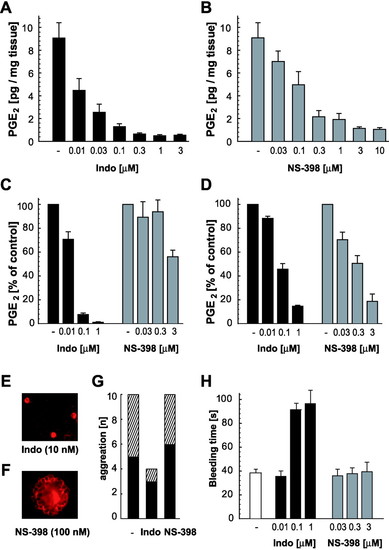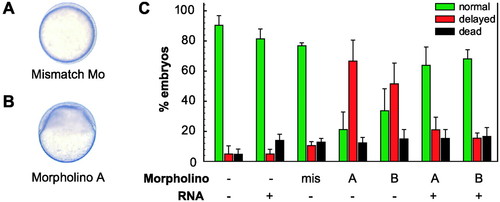- Title
-
Developmental expression of functional cyclooxygenases in zebrafish
- Authors
- Grosser, T., Yusuff, S., Cheskis, E., Pack, M.A., and FitzGerald, G.A.
- Source
- Full text @ Proc. Natl. Acad. Sci. USA
|
(A and B) Inhibition of PGE2 formation in adult zebrafish by (A) indomethacin (IC50 13 nM) and (B) NS-398 (IC50 93 nM). The data are means (±SEM) of seven independent experiments. (C and D) Analysis of inhibitor selectivity in COS-7 cells overexpressing either (C) zCOX-1 or (D) zCOX-2. Data are means (±SEM) of four experiments. (E-G) Zebrafish thrombocyte aggregation induced ex vivo by ADP (16 μM) after exposure of adult zebrafish to either indomethacin or NS-398. (E) A representative experiment showing single thrombocytes after ADP stimulation in blood from an indomethacin-treated fish. Immunostaining for GPIIb/IIIa was used as a thrombocyte marker. (F) Thrombocyte aggregation induced by ADP in blood from an NS-398-exposed fish. (G) In indomethacin (Indo)-treated fish, the frequency of observed aggregation was reduced to four of 10 experiments, whereas vehicle or NS-398-treated zebrafish exhibited platelet aggregation in all experiments either spontaneously (black bars) or ADP-induced (hatched bars) in 10 experiments per treatment group. (H) Bleeding time (seconds) in adult zebrafish after exposure to various concentrations of indomethacin and NS-398. Only the nonselective inhibitor indomethacin resulted in prolongation of bleeding time. Data are means (± SEM) of five experiments per group. |
|
(a) Analysis of zCOX-1 and zCOX-2 transcript expression in adult zebrafish. We assessed constitutive zCOX isoform expression in adult zebrafish by reverse transcriptase-PCR using total RNA from freshly dissected adult organs. PCR products (500 bp and 162 bp) and the corresponding negative controls were visualized by agarose gel-electrophoresis. Expression of zCOX-1 (b, e, h, k, n, and q), zCOX-2 (c, f, i, l, o, and r), and flk-1 (d, g, j, m, p, and s) by whole-mount in situ hybridization in zebrafish larvae at 96 hpf. zCOX-1 (b), zCOX-2 (c), and the endothelial marker flk-1 (d) are expressed in the carotid artery (ca) and the pharyngeal arches (white arrow) (lateral view). zCOX-1 (b) and flk-1 (d) are also present in cranial arteries (arrowheads). (e-g) Ventral views showing expression in the pharyngeal arches (arrowheads). While flk-1 staining (g) highlights the vasculature in the center of the arches [arch arteries 1 and 2 (opercular artery); 3-6,ha, hypobranchial artery (35)], zCOX-1 (e) and zCOX-2 (f) appear to be expressed in more peripheral structures of the arches. (h-j) Oblique ventral views. zCOX-1 (h), zCOX-2 (i), and flk-1 (j) colocalize and are expressed within sprouting gill arteries (*) that are apparent as protrusions at the caudal surface of arch arteries 3-6. (k-m) Histological cross sections through these vessels (*, section rotated by 90°) show flk-1 (m) expression in endothelial cells. zCOX-2 is highly expressed in the vessel wall of the sprouting gill vasculature (l). zCOX-1 expression is less intense and appears to be present in both endothelial and wall structures (k). (n-p) Endothelial expression of zCOX-1 was seen the ciliary arteries of the eye (n, arrowheads), which were also visible in flk-1 (p), but not in zCOX-2-stained embryos (o). zCOX-1 and zCOX-2 were both differentially expressed in other structures of the developing eye (n and o). (q-s) All three genes were expressed in the vasculature of the intestine. Endothelial cells are highlighted by arrowheads. (Magnifications: (b-j) x200, (k-m and q-s) x630, n-p) x400.) |
|
Morpholino knockdown of zCOX-1. (A and B) Micrographs of zebrafish embryos (Normarski optics) at 11 hpf. Embryo (A) was injected with a control mismatch morpholino (0.85 ng) in the one-cell stage and has progressed normally to the tailbud stage. Embryonal cells have migrated around the yolk and the embryonal axis has been established. Embryo (B) was injected with 0.85 ng zCOX-1 antisense morpholino and is severely delayed in its development. Embryonal cells are covering only 40% of the yolk (40% epiboly). (C) Phenotypic rescue by zCOX-1 RNA. Embryos were classified as normally developed (green bars) or delayed (red bars) at 12 hpf. Lethality at 12 hpf is shown by the black bars. Embryos were microinjected in the one-cell stage with either mismatch morpholino (mis), 0.85 ng morpholino zCOX-1A (A), or 0.85 ng morpholino zCOX-1B (B). The ratio of delayed/normal embryos was reversed when COX-1 RNA (200 pg) was injected simultaneously with the antisense morpholinos as compared with the morpholinos alone. Each treatment group consists of injections of four different egg lays and minimally 160 individual embryos in total. Data are means (±SEM) of percent embryos in each set of delivered eggs. PHENOTYPE:
|



